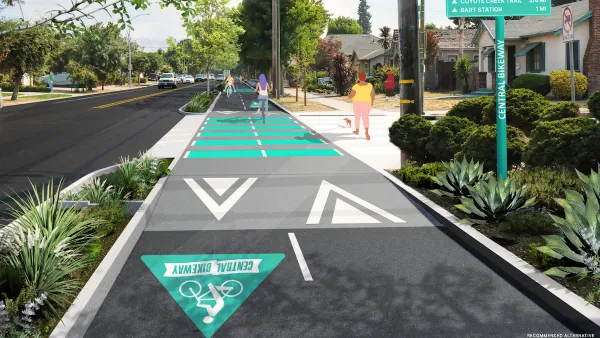Let me start with a disclaimer: I am not a transportation planner. At the points where transportation planning shares borders with engineering, I tend to zone out and start doodling in the margins. I do, however, have a lifelong interest in transportation, which is why I share the excitement of some of my more transportation-focused colleagues about potential changes in how California measures transportation impacts of projects.
Let me start with a disclaimer: I am not a transportation planner. At the points where transportation planning shares borders with engineering, I tend to zone out and start doodling in the margins. I do, however, have a lifelong interest in transportation, which is why I share the excitement of some of my more transportation-focused colleagues about potential changes in how California measures transportation impacts of projects.
The California Environmental Quality Act (CEQA) measures transportation impacts of proposed projects with a traditional Level of Service (LOS) metric. Because LOS measures the speed and free-flow of automobiles as the proxy for impact, any changes that impede cars end up determined as having a (potentially) negative impact. Since slower moving transit, bikes and pedestrians slow down cars, changes that benefit these modes all come up as having negative impacts. Although California doesn't require projects be abandoned because of these impacts, where feasible the negative impacts must be mitigated. Thus, there is a de facto imbalance in determining impacts and improvements for alternative modes can end up far costlier because lessening the impact on cars may have to be rolled into the cost.
California's legislative attempts to require that greenhouse gas levels be reduced to 1990 levels by 2020, however, have led to a sequence of events that are likely to change this modal balance of power. The Governor's Office of Planning and Research (OPR), the body responsible for writing and amending the CEQA guidelines related to transportation and traffic, is considering de-emphasizing the LOS standard, relying instead on a Vehicle Miles Travelled (VMT) standard. OPR believes that because VMT is more closely tied to greenhouse gases than is LOS, it will VMT will provide a better understanding of potential environmental impacts of proposed developments.
For the advocates who have long sought these changes, this is great news. For example, under an LOS model, widening a road is a reasonable way to accommodate more vehicle trips. Under a VMT metric, however, road widening provides the opposite result. Improved pedestrian infrastructure - signaled crosswalks, or streets that are closed to private vehicles - do poorly under an LOS analysis but are beneficial when measuring VMT.
As reported by Streetsblog SF's Matthew Roth, Terry Roberts, Director of the State Clearinghouse at the OPR, said "OPR had been receiving suggestions months and months ago from various parties, some from local governments, others were environmental organizations, and they all seemed to be saying the same thing to OPR and that is the over-emphasis on Level of Service in the CEQA analysis of a project was creating obstacles to better planning and smart growth."
It isn't clear that these changes will make it over every hurdle they must clear to be implemented. Less certain still is whether or not LOS will be removed from CEQA, or just de-emphasized. I certainly hope for the former, which would be a big step towards multi-modal transportation analysis of environmental impacts and, perhaps, a boost for bikes, peds, and transit.

Planetizen Federal Action Tracker
A weekly monitor of how Trump’s orders and actions are impacting planners and planning in America.

Silicon Valley ‘Bike Superhighway’ Awarded $14M State Grant
A Caltrans grant brings the 10-mile Central Bikeway project connecting Santa Clara and East San Jose closer to fruition.

Amtrak Cutting Jobs, Funding to High-Speed Rail
The agency plans to cut 10 percent of its workforce and has confirmed it will not fund new high-speed rail projects.

California Set to Increase Electric Truck Chargers by 25%
The California Transportation Commission approved funding for an additional 500 charging ports for electric trucks along some of the state’s busiest freight corridors.

21 Climate Resilience Projects Cancelled by the EPA
The federal government has pulled funding for at least 21 projects related to farming, food systems, and environmental justice to comply with one of Trump’s early executive orders.

Trump Executive Order on Homelessness Calls for Forced Institutionalization
The order seeks to remove legal precedents and consent decrees that prevent cities from moving unhoused people from the street to treatment centers.
Urban Design for Planners 1: Software Tools
This six-course series explores essential urban design concepts using open source software and equips planners with the tools they need to participate fully in the urban design process.
Planning for Universal Design
Learn the tools for implementing Universal Design in planning regulations.
Yukon Government
Caltrans
New Jersey Institute of Technology
Mpact (founded as Rail~Volution)
City of Camden Redevelopment Agency
City of Norman, Oklahoma
City of Portland
City of Laramie



























